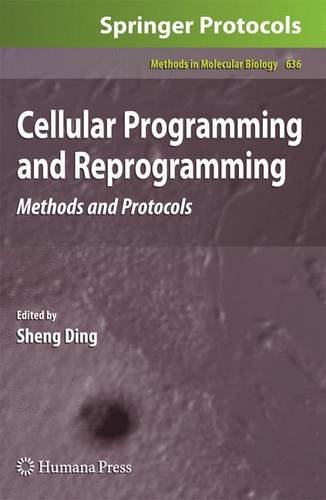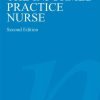Cellular Programming and Reprogramming Methods and Protocols 1st Edition by Ge Lin, Kristen Martins Taylor, Ren He Xu, Sheng Ding 9781607616900 1607616904
$50.00 Original price was: $50.00.$35.00Current price is: $35.00.
Cellular Programming and Reprogramming Methods and Protocols 1st Edition by Ge Lin, Kristen Martins Taylor, Ren He Xu, Sheng Ding – Ebook PDF Instant Download/Delivery: 9781607616900, 1607616904
Full download Cellular Programming and Reprogramming Methods and Protocols 1st Edition after payment

Product details:
ISBN 10: 1607616904
ISBN 13: 9781607616900
Author: Ge Lin, Kristen Martins Taylor, Ren He Xu, Sheng Ding
Before the therapeutic potential of cell replacement therapy or the development of therapeutic drugs for stimulating the body’s own regenerative ability to repair cells damaged by disease and injury can be fully realized, control of stem cell fate, immuno-rejection, and limited cell sources must be overcome. In Cellular Programming and Reprogramming: Methods and Protocols, expert researchers cover the most recent technologies and their related mechanisms involved in the programming and reprogramming of cell fate. Written in the highly successful Methods in Molecular Biology™ series format, chapters include introductions to their respective topics, lists of the necessary materials and reagents, step-by-step, laboratory protocols, and notes to highlight tips on troubleshooting and avoiding known pitfalls.
Essential and cutting-edge, Cellular Programming and Reprogramming: Methods and Protocols promises to aid scientists attempting to advance stem cell biology in order to better treat devastating human diseases, including cardiovascular disease, neurodegenerative disease, musculoskeletal disease, diabetes, and cancer.
Cellular Programming and Reprogramming Methods and Protocols 1st Table of contents:
Chapter 1: Human Embryonic Stem Cell Derivation, Maintenance, and Differentiation to Trophoblast
1. Introduction
2. Materials
2.1. Reagents
2.2. Supplies
3. Methods
3.1. hESC Derivation
3.1.1. Thawing and Culture of Human Embryos
3.1.2. Preparation of MEF-Coated Plate
3.1.3. Isolation of the Inner Cell Mass from Human Blastocysts
3.1.4. Primary Culture of the ICM
3.1.5. Continuing Propagation of the hESC Cells
3.2. hESC Culture
3.2.1. Culture in hESC Medium on MEF (1–3)
3.2.2. Culture in MEF-Conditioned hESC Medium on Matrigel (4)
3.2.3. Culture in mTeSR1 Medium on Matrigel (16, 21)
3.3. Validation and Quality Control of hESCs
3.3.1. Alkaline Phosphatase Detection
3.3.2. Immunocytochemistry Detection for Cell Surface Markers in hESCs (Fig. 2)
3.3.3. Immunocytochemistry Detection for Nuclear Markers in hESCs (Fig. 2)
3.3.4. Embryoid Body Formation (23, 24)
3.3.5. Teratoma Formation
3.3.6. Information for Other Quality Control Assays
3.4.hESC Differentiation to Trophoblast (5)
3.4.1. Trophoblast Induction
3.4.2. Induction of Syncytial Trophoblast
3.4.3. Characterization of the Induced Trophoblast
3.4.3.1. IImmunoŁcytochemistry
3.4.3.2. Placental Hormone Measurement
4. Notes
References
Chapter 2: Isolation and Maintenance of Mouse Epiblast Stem Cells
1. Introduction
2. Materials
2.1. Mouse Embryonic Fibroblasts
2.2. Epiblast Isolation
2.3. EpiSC Culture
2.4. EpiSC Characterization
2.4.1. RNA Extraction
2.4.2. Semiquantitative Reverse Transcription Polymerase Chain Reaction
2.4.3. Oct3/4 Luciferase Reporter Assay
3. Methods
3.1. MEFs
3.1.1. MEF Isolation
3.1.2. MEF Passaging, Freezing, and Thawing
3.1.3. Mitotic Inactivation of MEFs
3.2. Isolation and Culture of the Postimplantation Epiblast
3.2.1. Isolation of 5.5 dpc Postimplantation Mouse Embryos
3.2.2. Separation of Tissues from 5.5 dpc Mouse Embryos
3.2.3. Plating and Culture of Primary Epiblast Tissue
3.3. EpiSC Culture
3.3.1. Passage of Primary Epiblast Outgrowth
3.3.2. Routine Passaging of EpiSCs
3.3.3. Cryopreservation of EpiSCs
3.3.4. Thawing of EpiSCs
3.4. Basic Characterization of EpiSCs
3.4.1. Total RNA Extraction from EpiSCs
3.4.2. Reverse Transcription Using Total RNA
3.4.3. PCR Detection of Target cDNA
3.4.4. Oct3/4 Luciferase Reporter Assay
4. Notes
References
Chapter 3: Functional Assays for Hematopoietic Stem Cell Self-Renewal
1. Introduction
1.1. Phenotypic Identification of Putative HSCs
1.2. Functional Assays for HSCs
1.3. Long-Term Repopulation Assay
1.4. Competitive Repopulation Assay
1.5. Limiting-Dilution Assay
1.6. Serial Transplantation Assay
2. Materials
2.1. Recipient Mice/Competitor Cell Donors
2.2. Donor Mice for Test Cells
2.3. Reagents/Equipment
3. Methods
3.1. Preparation of Recipient Mice
3.2. Preparation of Test and Competitor Cells
3.3. Transplantation
3.4. Evaluation of Engraftment
4. Notes
References
Chapter 4: Isolation Procedure and Characterization of Multipotent Adult Progenitor Cells from Rat Bone Marrow
1. Introduction
2. Materials
2.1. Isolation of Rat MAPC from Bone Marrow and Cell Culture
2.2. Characterization of MAPC and Quality Control
2.2.1. mRNA Expression of Pluripotency Markers and Lineage-Specific Genes
2.2.2. Flow Cytometry
2.2.3. Immunocyto-chemistry
2.2.4. Hepatocyte Differentiation (Endoderm)
2.2.5. Endothelial Differentiation (Mesoderm)
2.2.6. Neuroectoderm Differentiation
2.3. Cytogenetics by G-Banding
3. Methods
3.1. Isolations of Rat MAPC from Bone Marrow
3.1.1. Bone Marrow Aspiration from E18 and 3/4-Week-Old Rats
3.1.2. High-Density Culture of Cells for 1 Month
3.1.3. Column Depletion of CD45+ Population
3.1.4. Subcloning, Culture, and Screening of Potential MAPC Clones
3.2. Expansion or Maintenance Culture of MAPC Lines (see Note 5)
3.2.1. Coating of Wells and Dishes
3.2.2.Procedure for Thawing MAPC
3.2.3. Passaging of MAPC Lines
3.2.4. Procedure for Freezing MAPC
3.3. mRNA Expression of Pluripotency Markers
3.3.1. Preparation of Cell Lysates
3.3.2. Total RNA Isolation with Mini Kit
3.3.3. DNAse Treatment
3.3.4. Prepare cDNA with Superscript III First-Strand Synthesis System of RT-PCR
3.3.5. Quantitative Real-Time Polymerase Chain Reaction with Eppendorf Mastercycler ep Realplex
3.4. Flow Cytometry
3.4.1. Expression of Surface Markers by FACS Analysis (Fig. 4.3a)
3.4.2. Intracellular Staining for Oct4 by Flow Cytometry (Fig. 4.3a)
3.5. Immunocyto-chemistry
3.6. Multilineage Differentiation Capacity
3.6.1. Hepatocyte Differentiation (Endoderm)
3.6.2. Endothelial Differentiation (Mesoderm)
3.6.3. Neuroectoderm Differentiation
3.7. Cytogenetics by G-Banding
3.8. Screening of Mycoplasma Contamination
4. Notes
References
Chapter 5: Generation of Functional Insulin-Producing Cells from Human Embryonic Stem Cells In Vitro
1. Introduction
2. Materials
2.1. Human ES Cell Line Expansion
2.2. Human ES Cell Differentiation
2.3. Human ES Cell Transplantation
3. Methods
3.1. Day 0 Prepare hES Cells for Differentiation
3.2. Days 1–4 Induce Human ES Cells to Differentiate into Definitive Endoderm Cells
3.3. Days 5–8 Pancreatic Lineage Specification from Differentiated Human ES Cells
3.4. Days 9–20 Insulin-Producing Cell Matured from Differentiated Human ES Cells
3.5. Transplantation of the Differentiated Insulin-Producing Cells Derived from hES Cells In Vivo
4. Notes
References
Chapter 6: Mesoderm Cell Development from ES Cells
1. Introduction
1.1. Mesoderm Development in the Embryos
1.2. Flat Culture for In Vitro ES Cell Culture
1.3. Differentiation of Mesoderm Cells in In Vitro ES Cell Culture
2. Materials
2.1. ES Cell Lines
2.2. ES Cell Maintenance
2.3. OP9 Stromal Cell Maintenance
2.4. In Vitro ES Cell Differentiation Without OP9
2.5. In Vitro ES Cell Differentiation with OP9
2.6. Purification of Mesoderm Cells
2.7. Bone Cell Differentiation from ES Cell-Derived Mesoderm Cells
2.8. Cartilage Cell Differentiation from ES Cell-Derived Mesoderm Cells
2.9. Hematopoietic Cell Differentiation from ES Cell-Derived Mesoderm Cells
2.10. Endothelial Cell Differentiation from ES Cell-Derived Mesoderm Cells (ES Cell-Derived Endothelial Colony Assay)
3. Methods
3.1. ES Cell Culture
3.1.1. Gelatin Coating of Dishes
3.1.2. Thawing of ES Cells
3.1.3. Passage of ES Cells
3.1.4. Cell Freezing
3.2. Maintenance of OP9 Stromal Cell Line for In Vitro ES Cell Differentiation
3.2.1. Thawing of OP9 Cells
3.2.2. Passage of OP9
3.2.3. Storing of OP9
3.3. In Vitro ES Cell Differentiation
3.3.1. Induction of Mesoderm Cells Without OP9 Cells
3.3.2. Induction of Mesoderm Cells with OP9 Cells
3.3.3. Purification of Mesoderm Cells from the Culture Without OP9
3.3.4. Purification of Mesoderm Cells from the Culture with OP9
3.4. Differentiation into Descendants of the Mesoderm Cells
3.4.1. Induction of Bone Cells
3.4.2. Alizarin Red Staining
3.4.3. Induction of Cartilage Cells
3.4.4. Alcian Blue Staining
3.4.5. Induction of Hematopoietic Cells
3.4.5.1. Generation of Primitive Erythrocytes
3.4.5.2. Generation of Definitive Hematopoietic Cells
3.4.6. Endothelial Cell Colony Assay
4. Notes
References
Chapter 7: Directed Differentiation of Red Blood Cells from Human Embryonic Stem Cells
1. Introduction
2. Materials
2.1. hESC Culture
2.2. Embryoid Body (EB) Formation
2.3. Blast Cell Growth and Expansion
2.4. Erythroid Enucleation
3. Methods
3.1. Preparation of PMEF Feeder
3.2. Culture of Undifferentiated hESCs
3.2.1. Thawing Frozen hESCs
3.2.2. Splitting hESCs
3.3. Induction of hESC Differentiation (EB Formation) and Expansion of Blast Cells
3.4. Erythroid Cell Differentiation and Expansion
3.5. Enucleation of Erythroid Cells In Vitro
4. Notes
References
Chapter 8: Directed Differentiation of Neural-stem cells and Subtype-Specific Neurons from hESCs
1. Introduction
2. Materials
2.1. Stock Solutions
2.2. Media
2.3. Antibodies
2.3.1. For Neuroepithelial Cell Identity
2.3.2. For Regional Identity
2.3.3. For Neurons and Progenitors
2.3.4. For Motor Neurons and Progenitors
2.4. Culture Substrate Preparation
3. Methods
3.1. Induction of Neuroepithelial Cells
3.1.1. Lift hESC Colonies from MEF Feeder Cells
3.1.2. Formation of hESC Aggregates (or Embryoid Bodies)
3.1.3. Differentiation of Primitive Neuroepithelial Cells
3.2. Specification of Olig2-Expressing Motoneuron Progenitors
3.3. Generation of Spinal Motor Neurons
3.4. Maturation of Spinal Motor Neurons
3.5. Passaging Neuroepithelial Spheres
3.5.1. Passage Cells Using Polished Pasteur Pipette
3.5.2. Splitting Big Neuroepithelial Spheres Using ACCUTASE
3.6. Plate Cells on Coverslips that Are Coated with Polyornithine and Laminin
4. Notes
References
Chapter 9: Directing Human Embryonic Stem Cells to a Retinal Fate
1. Introduction
2. Materials
2.1. Culture of Undifferentiated Human Embryonic Stem Cells
2.2. Generation of Retinal Cells from Undifferentiated Human ES Cells
2.3. Coating for Adherent Culture of Cells
2.4. Manipulation of Notch Pathway in Human ES Cell-Derived Retinal Cells
2.5. Subretinal Transplantation of Retinal Cells in Adult Mice
2.6. Quantitative PCR
2.7. Immunocytochemistry
3. Methods
3.1. Culture of Undifferentiated Human Embryonic Stem Cells
3.2. Substrate for Adherent Culture of Cells
3.3. Generation of Retinal Cells from Undifferentiated Human ES Cells (Fig. 9.2a)
3.4. Analysis of Retinal Determination Using Quantitative Real-Time PCR
3.5. Analysis of Retinal Determination Using Fluorescent Immunohistochemistry
3.6. Forced Differentiation of Human ESc-Derived Retinal Progenitors Using Inhibitors of Notch Pathway
3.7. Subretinal Injectionof Dissociated Cells Into Adult Mouse Recipients
References
Chapter 10: Bovine Somatic Cell Nuclear Transfer
1. Introduction
2. Materials
2.1. Equipment
2.2. Oocyte Collection and Maturation
2.3. Micropipette Preparation
2.4. Somatic Cell Nuclear Transfer
3. Methods
3.1. Oocyte Collection and Maturation
3.2. Micropipette Preparation
3.2.1. Holding Pipette
3.2.2. Enucleation and Transfer Pipettes
3.3. Nuclear Transfer
3.3.1. Preparation of Culture Dishes for Embryo Manipulation
3.3.2. Preparation of Recipient Oocytes
3.3.3. Setup of Manipulation Chamber and Tools
3.3.4. Oocyte Enucleation
3.3.5. Cell Transfer
3.3.6. Oocyte–Cell Fusion
3.3.7. Oocyte Activation (see Note 6)
3.4. Embryo Culture
4. Notes
References
Chapter 11: Cell Fusion-Induced Reprogramming
1. Introduction
2. Materials
2.1. Cell Culture: ES Cells, Neural Stem Cells, and Mouse Embryonic Fibroblasts
2.2. Cell Fusion
2.3. Selection of Fusion Hybrid Cells
2.4. Freezing and Thawing of Fusion Hybrid Cells
3. Methods
3.1. ES Cell (E14 and HM-1) Culture
3.2. Preparation of NSCs for Somatic Fusion Partner Cells
3.3. Preparation of MEFs for Somatic Fusion Partner Cells
3.4. Cell Fusion
3.5. Selection and Further Culture of Fusion Hybrid Cells
3.5.1. Drug Selection
3.5.2. FACS Sorting for Oct4-GFP-Positive Cells
3.6. Freezing and Thawing of Fusion Hybrid Cells
3.6.1. Freezing
3.6.2 .Thawing
4. Notes
References
Chapter 12: An Improved Method for Generating and Identifying Human Induced Pluripotent Stem Cells
1. Introduction
2. Materials
2.1. Tissue Culture
2.2. Retrovirus Production
3. Methods
3.1. Preparation of Cell Culture Media
3.1.1. Media and Feeder Cells for hES and iPS Cells
3.1.2. Media for Human Fibroblasts
3.2. Retroviral Production and Usage
3.2.1. Production of Recombinant Retroviruses
3.2.2. Usage of Recombinant Retroviral Vectors
3.3. Basic Reprogramming Procedure
3.4. Human iPS Colony Identification and Picking
3.5. Initial iPS Clone Expansion and Characterization
4. Notes
References
Chapter 13: Using Small Molecules to Improve Generation of Induced Pluripotent Stem Cells from Somatic Cells
1. Introduction
2. Materials
2.1. MEF Derivation
2.2. Cell Culture
2.2.1. MEF Media
2.2.2. Plat-E Cell Media
2.2.3. mES Cell Media
2.2.4. 2× Freezing Media for iPS Cells
2.3. Retroviruses Production and Transduction
2.4. Compounds
2.5. Detection and Identification of iPSCs
2.5.1. Alkaline Phosphatase Detection Kit (Millipore)
2.5.2. Primary Antibodies
2.5.3. Secondary Antibodies
2.5.4. Blocking Buffer Composition
3. Methods
3.1. MEF Derivation
3.2. Retrovirus Production
3.3. Transduction of MEF Cells
3.4. Observation of iPS Cell Generation
3.5. Confirmation of Pluripotency Status of the GFP+ iPS Cell Colonies
3.5.1. For Propagation
3.5.2. iPS Cell Characterization
3.5.3. Alkaline Phosphatase Staining
3.5.4. Immunostaining
4. Notes
References
Chapter 14: Reprogramming of Committed Lymphoid Cells by Enforced Transcription Factor Expression
1. Introduction
2. Materials
2.1. Transient Transfection of Packaging Cell Lines with Retroviral Vectors to Produce Ecotropic Retroviral Supernatants
2.2. Isolation of Cell Population of Interest from Bone Marrow or Thymus of Mice
2.2.1. Lineage Tracer Mice
2.2.2. Isolation of B lineage Cells from Bone Marrow
2.2.3. Isolation of Pre-T cells from Thymus
2.3. Infection of Primary Cells of Interest with Retroviruses
2.4. Coculture of Infected Primary Cells with Stromal Cells
2.5. Analysis of Infected Cells Using Multicolor Flow Cytometry and Fluorescence Microscopy
3. Methods
3.1. Transient Transfection of Packaging Cell Lines with Retroviral Vectors to Produce Ecotropic Retroviral Supernatants
3.2. Isolation of Cell Populations of Interest from Bone Marrow, Spleen or Thymus of Mice
3.2.1. Lineage Tracer Mice
3.2.2. Isolation of B Cells from Bone Marrow
3.2.3. Isolation of Pre-T Cells from Thymus
3.3. Infection of Primary Cells of Interest with Retroviruses
3.4. Coculture of Infected Primary Cells with Stromal Cells
3.4.1. B Cell Cocultures with S17 Stromal Cells (16)
3.4.2. T Cell Cocultures with S17 Stromal Cells or OP9-Delta-Like 1 Stromal Cells (17)
3.5. Analysis of Infected Cells Using Multicolor Flow Cytometry and Fluorescence Microscopy
3.5.1. Cell Harvesting from Cocultures
3.5.2. Antibody Labeling
3.5.3. Flow Cytometry
3.5.4. Data Analysis
3.6. An Assay for the Detection of Synergistic and Antagonistic Transcription Factor Interactions
4. Notes
References
Chapter 15: Reprogramming of B Cells
1. Introduction
1.1. The Many Ways to Reprogramming
1.2. B Cells as the Starting Material: Plasticity During Normal B Cell Development
1.3. The Dark Side of Plasticity: Tumoral Reprogramming
1.4. Taking Advantage of Pax5-Dependent B Cell Plasticity: Reprogramming B Cells into Early Progenitors
2. Materials
3. Methods
4. Notes
References
Chapter 16: Adult Cell Fate Reprogramming: Converting Liver to Pancreas
1. Introduction
2. Materials
2.1. Liver Cells Isolation
2.2. Primary Cultures of Liver Cells: Maintenance and Treatment
2.3. Adenovirus Propagation
2.4. Luciferase Assay
2.5. Isolation of RNA from Human Liver Cells Using TRI Reagent
2.6. DNase Treatment (DNA-free™, Ambion)
2.7. Reverse Transcriptase Reaction
2.8. Quantitative RT-PCR Analysis Using SYBR® Green
2.9. Quantitative RT-PCR Analysis Using TaqMan® Probes
2.10. Western Blot Analysis
2.11. Immunofluore-scence Analyses
2.12. Insulin and C-Peptide Content and Glucose Regulated Secretion
2.13. Amelioration of Hyperglycemia Upon Implantation in Diabetic SCID–NOD Mice
3. Methods
3.1. Adult Liver Cells (see Note 1)
3.1.1. Liver Cells Isolation
3.1.2. Primary Cultures of Liver Cells: Maintenance and Treatment (see Note 5)
3.2. Adenoviruses
3.2.1. Propagation of First Generation Recombinant Adenovirus
3.2.2. Propagation of Ad-Easy Adenoviruses
3.2.3. Viral Particle Titration: TCID50 Methods (37)
3.3. Activation of the Pancreatic Lineage in Adult Human Liver Cells, In Vitro
3.3.1. Determine the Efficiency of Adenoviruses Infection of Adult Human Liver Cells, In Vitro
3.3.2. Activation of Ectopic Insulin Promoter
3.3.2.1. Using Ad-RIP-GFP
3.3.2.2. Using Ad-RIP-Luciferase
3.3.3. Molecular Analyses of the Developmental Redirection Process, Quantitative RT-PCR (see Note 8)
3.3.3.2. DNase Treatment (DNA-free™, Ambion)
3.3.3.3. Reverse Transcriptase Reaction
3.3.3.4. Quantitative RT-PCR Analysis Using SYBR® Green
3.3.3.5. Quantitative RT-PCR Analysis Using TaqMan® Probes
3.3.4. Cellular Analysis of the Developmental Redirection Process
3.3.4.1. Western Blot Analysis
3.3.4.1.1. Preparation of Western blot
3.3.4.1.2. Antibodies and Protein Detection
3.3.4.2. Immunofluore-scence Analyses
3.3.4.3. Insulin Content
3.3.4.3.1. RadioImmunoAssay (RIA) Analyses for Insulin and C-Peptide
3.3.5. Functional Analysis of the Developmental Redirection Process In Vitro
3.3.5.1. Insulin and C-Peptide Secretion
3.3.5.2. Preparation of Transdifferentiated Liver Cells for Transplantation
3.3.5.3. Induction of Diabetes in SCID–NOD Mice
3.3.5.4. Implantation of Cells Under the Kidney Capsule of the Diabetic Mice
4. Notes
References
Chapter 17: In Vitro Reprogramming of Pancreatic Cells to Hepatocytes
1. Introduction
2. Materials
3. Methods
4. Notes
References
Chapter 18: Generation of Novel Rat and Human Pluripotent Stem Cells by Reprogramming and Chemical Approaches
1. Introduction
2. Materials
2.1. Cell Culture
2.2. Viral Package and Cell Transduction
2.3. Cytochemistry and Immunofluorescence Assay
2.4. Teratoma Assay
3. Methods
3.1. Generation of Rat Induced Pluriopotent Stem Cells (riPSCs)
3.1.1. Retroviral Package and Target Cell Transduction
3.1.2. The Establishment and Culture of riPSCs
3.1.3. The Pluripotency of riPSCs
3.2. Generation of Mouse ES Cell-Like Human Induced Pluripotent Stem Cells
3.2.1. Lentiviral Package and Target Cell Transduction
3.2.2. The Establishment and Culture of Mouse ES Cell-Like Human Induced Pluripotent Stem Cells
3.2.3. The Pluripotency of Mouse ES Cell-Like Human Induced Pluripotent Stem Cells
4. Notes
References
Chapter 19: Small Molecule Screen in Zebrafish and HSC Expansion
1. Introduction
2. Materials
2.1. Embryo Preparation
2.2. Chemical Libraries and Chemical Screen
2.3. Embryo Fixation, Dechorionation, Bleaching, Rehydration, and Proteinase K Treatment
2.4. Hybridization
2.5. DIG Staining (see Note 11)
2.6. Probe Preparation
2.7. Observation and Photography
3. Methods
3.1. Embryo Preparation
3.2. Chemical Libraries
3.3. In Situ Hybridization ( see Note 16)
3.3.1. Embryo Dechorionation, Fixation, Bleaching and Rehydration, and Proteinase K Treatment
3.3.2. Hybridization
3.3.3. DIG Staining
3.3.4. Probe Preparation
3.3.5. Observation and Photography
3.4. Chemoinformatics ( 19, 20)
4. Notes
References
Chapter 20: Zebrafish Small Molecule Screen in Reprogramming/Cell Fate Modulation
1. Introduction
2. Materials
2.1. Zebrafish
2.2. Chemical Screening in Zebrafish Embryos
2.3. Incubation and Fixation of Compound-Treated Zebrafish Embryos
2.4. Digoxigenin Probe Labeling
2.5. Whole-Mount In Situ Hybridization
3. Methods
3.1. Collection of Zebrafish Embryos
3.2. Arraying the Embryos and Administering the Chemicals
3.3. Heat-Shock Treatment and Fixing the Embryos
3.4. Digoxigenin Labeling of Antisense RNA Probe
3.5. Whole-Mount In Situ Hybridization
4. Notes
People also search for Cellular Programming and Reprogramming Methods and Protocols 1st:
cellular reprogramming definition
cellular programming
cellular reprogramming methods
cellular reprogramming journal
cellular programming and reprogramming
Tags: Cellular Programming, Reprogramming Methods, Ge Lin, Kristen Martins Taylor, Ren He Xu, Sheng Ding



